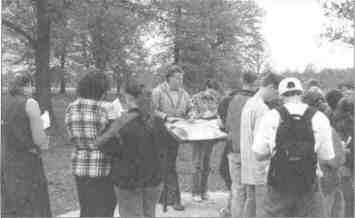 |
Home | Search | Browse | About IPO | Staff | Links |
 |
Home | Search | Browse | About IPO | Staff | Links |
|
The Wonders of Wetlands Eldon Hazlet State Park is using wetlands as a habitat-based learning experience.
STORY AND PHOTOS The old saying "If you build it, they will come" holds true at Eldon Hazlet State Park. When referring to "they," one might think of people flocking to a new mall or theme park. But, at Eldon Hazlet, "they" refers to aquatic plants and animals that have found a home in the new Wetland Education Area. Three years ago, the 17-acre field at the north end of the park was considered an eyesore that occasionally flooded with heavy rains. Today, the area is thriving with amphibians, shorebirds, wading birds, reptiles, waterfowl and aquatic plants. It all started in 1996 when Site Superintendent Gary Tatham and Marc Pedrucci, the park's site interpreter at the time, were planning new interpretive programs. "We wanted another area that we could use to conduct nature hikes," Tatham explained. "We already provided guided hikes through a restored prairie and a mature oak/hickory forest, so a wetland trail seemed a natural fit. We selected the field because the area was underutilized and naturally held water." Pedrucci coordinated the development of the wetland area between the park staff and DNR's resource biologists. The goal was to build a permanent shallow pond on the east end of the property, a wet prairie in the middle of the site,
The Wetland Education Area is a popular site for school groups. It allows

John Bunnell, natural coordinator, leads a guided hike through the Wetland Education Area. Interpretive signs along the trail provide information to hikers who wish to hike without a guide. a moist soil unit on the west end of the property and tie it all together with a quarter-mile, wheelchair-accessible hiking trail. Two permanent water-control structures were built in the pond and moist soil unit to control water levels. Prairie grasses were seeded in the upland area along with selected wildflowers. An old shelter at the end of the trail was renovated so that nature programs could be offered after a guided hike. In addition, six interpretive signs were placed along the trail, providing hikers with wetland information in case they hike the trail without a guide. For educators, the Wetland Education Area is viewed as a habitat-based learning site providing teachers and students with a unique, hands-on, outdoor learning experience. For example, one area high school teacher brings honor biology students to the park to study the ecological principles functioning in a wetland. Area grade school teachers bring students to the wetland to study mammals, birds, reptiles and amphibians that need wetlands in order to survive. The goal of the Wetland Education Program is twofold: to educate students and teachers about the importance of wetlands; and to use the wetlands as a tool to apply and connect science knowledge and skills to a number of academic principles. The area is a great outdoor classroom because hikers actually can see live animals. It is not uncommon to observe muskrats, northern water snakes or bullfrogs within a couple of feet of the trail. And waterfowl and wading birds constantly are using the area to feed and rest. At times, as if on cue, great blue herons or blue-winged teal will fly over the students and land in the water. Last April, the first-ever Carlyle Lake Education Day, an outdoor educational event for area grade school students, centered around the Wetland Educational Area. Programs on wetlands, watershed, water quality, fish management and water safety were conducted, all focusing on the rich water resources found in and around the Carlyle Lake watershed. More than 100 area fourth grade students attended the event. In fact, the Wetland Education Area has become so popular with area educators that its guided hike is requested more frequently than others at the park. In the spring of 2000 alone, more than 600 students and teachers toured the area. The long-term goal is to expand the program to the college level, possibly providing graduate students with research opportunities. One thing for sure, the aquatic plants and animals will be there waiting.
The Wetland Education Area was constructed in a portion
|
|||||||||||||
|
|